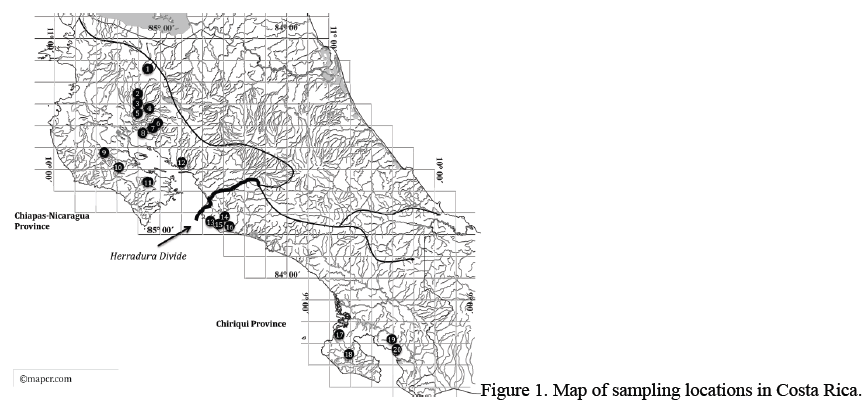April Larson and Dr. Jerald B. Johnson, Biology
One active area of study in ecology, termed biogeography, is the determination of how communities are formed. A basic knowledge of what factors have shaped the formation of ecological communities leads to greater understanding of a system as a whole and specific species interactions. One possible factor that is rarely taken into account when studying biogeography is the effect that early earth history events could have playing in the shaping of community boundaries. Molecular phylogeographic data is a useful tool in helping to determine the contribution of vicariant events in community formation. If single species genetic breaks coincide with community boundary breaks, we can infer that a vicariant event could have contributed to the observed pattern.
Smith and Bermingham (2005) studied community composition of fishes in Costa Rica and Panama and described fish community boundaries there. They were able to determine seven communities, which they termed biogeographic provinces. The way in which these specific provinces were formed though, is little understood. Using this data as a basis of our research, we looked at the boundary between two of the biogeographic provinces in Costa Rica. This area is called the Herradura Divide. Earlier studies have suggested that the Herradura Divide may be a geographic barrier in fish community composition (Lee & Johnson 2009). We focused on the widespread fish species, Poeciliopsis turrubarensis, whose range spans this Herradura Divide. If genetic breaks are found to exist within this species across the Herradura Divide, it would suggest that this is a geographic boundary in fish community composition. We looked specifically at specimens found north and south of the Herradura Divide region. We used molecular phylogeographic data from this widespread species to determine if genetic breaks within the species are congruent with the shift in the fish community composition at the Herradura Divide.
We collected Poeciliopsis turrubarensis specimen from 20 locations both north and south of the Herradura Divide between the years of 1998-2007 (Figure 1). Fish were preserved in ethanol in the field and then taken back to the lab for analysis.
We sequenced the mtDNA cytochrome b gene for 64 individuals collected from these sites. Of these individuals, there were 18 unique haplotypes, or gene types. In order to determine the phylogenetic relationships among these haplotypes, both maximum parsimony and maximum likelihood analyses were performed. Through these analyses, we discovered that there was a genetic break in Poeciliopsis turrubarensis across the Herradura Divide. Three of the haplotypes were restricted to populations north of this boundary, all other haplotypes were found south of the boundary. This is significant because it suggests that the Herradura Divide is a geographic barrier to fish movement and may have been an early earth history event that has shaped fish community composition.
Interestingly though, we also discovered a deeper genetic split between populations found in the far south of Costa Rica. This break seems to be unique and was unexpected because there was no community shift observed here by Smith and Bermingham (2005). This suggests that some factor, other than a shared vicariant event, accounts for this genetic break. Possibilities might include a shift in suitable habitat, a change in predator occurrence, or other biotic factors connected to Poeciliopsis turrubarensis life history.
This work has demonstrated how molecular phylogeographic findings can be used to better understand the transitions among fish biogeographic provinces. It has also opened the door to further research. It would be interesting to discover how frequently fish community boundaries are limited by abiotic vicariant events verses biotic interactions.
This work has been submitted for publication in the peer-reviewed journal, Journal of Fish Biology.
References
- Lee, J. B., & Johnson, J. B. (2009). Biogeography of the livebearing fish Poecilia gillii in Costa Rica: are phylogeographical breaks congruent with fish community boundaries? Molecular Ecology, 18(19), 4088-4101.
- Smith, S. A., & Bermingham, E. (2005). The biogeography of lower Mesoamerican freshwater fishes. Journal of Biogeography, 32(10), 1835-1854.

